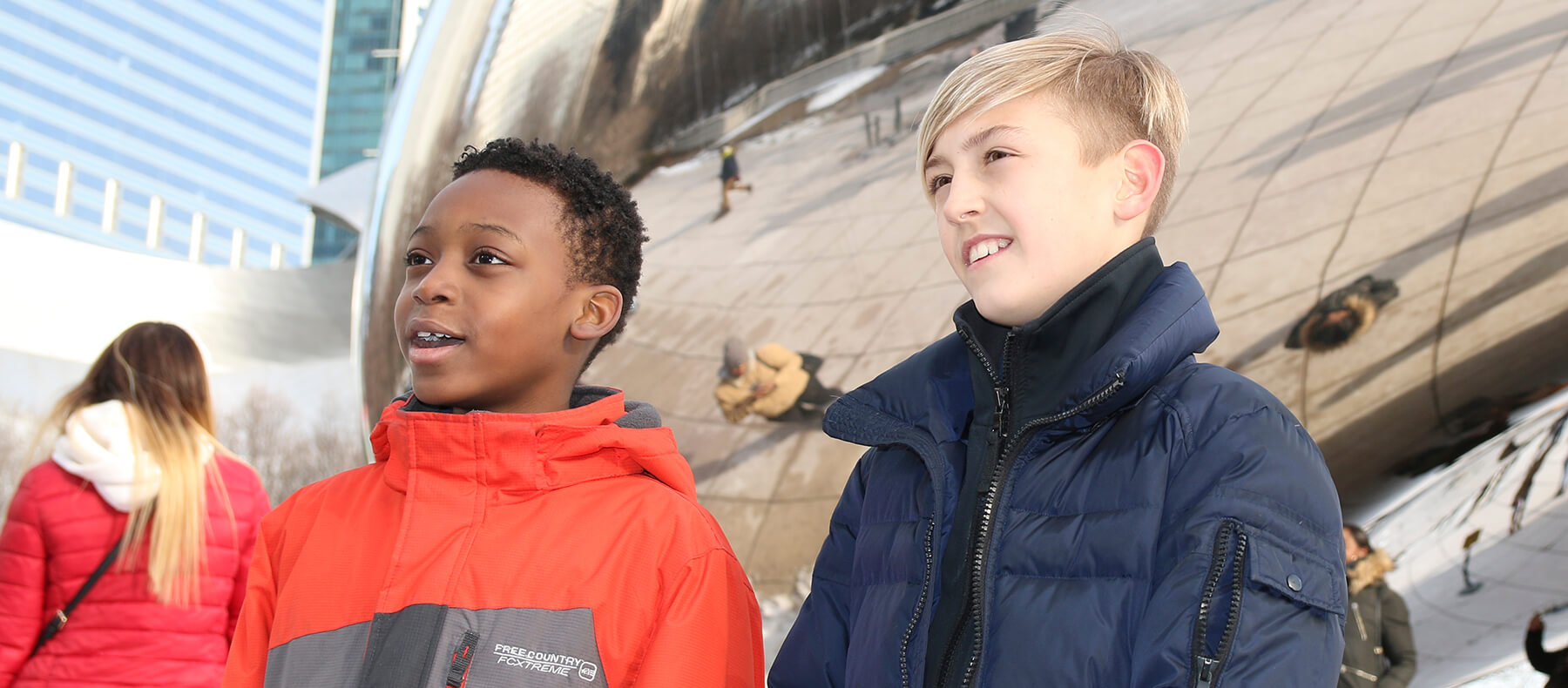
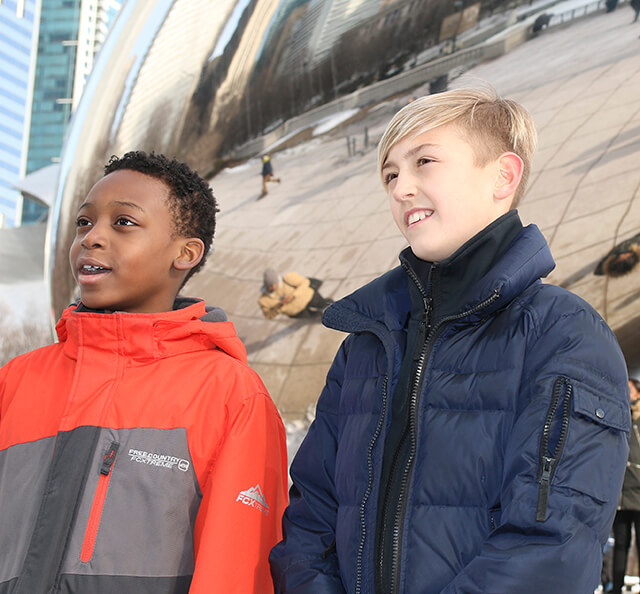
GRADES 6-8
Middle School Curriculum
OVERVIEW
Developing Independence & Confidence
The Middle Years Program (MYP) emphasizes intellectual challenge, encouraging students to make practical connections between their studies and the real world, and to grow comfortable taking risks, preparing them for success in further study and in life.


See For Yourself
Videos

International Baccalaureate Middle Years Program
Middle School at GEMS
The MYP is designed to provide a challenging framework for making connections between studies and the real world and develop both subject-specific and interdisciplinary understanding. Through our robust Field Studies program, students authentically apply their learning in a variety of settings. Students continue to develop the ten key attributes of the IB learner profile (LINK), which include becoming thinkers, risk-takers, and caring, balanced individuals. In middle school, we also highlight Approaches to Learning skills, which are the foundation for effective learning across all subjects and are explicitly taught. Students consistently reflect upon them as they develop their understanding of what it means to learn how to learn.
Middle School strategies, SKills & Attitudes
Approaches to Learning (ATLs)

Communication Skills
Communicating through language
Social/Collaboration Skills
Organizing
Managing State of Mind
Reflection
Research Skills
Media Literacy
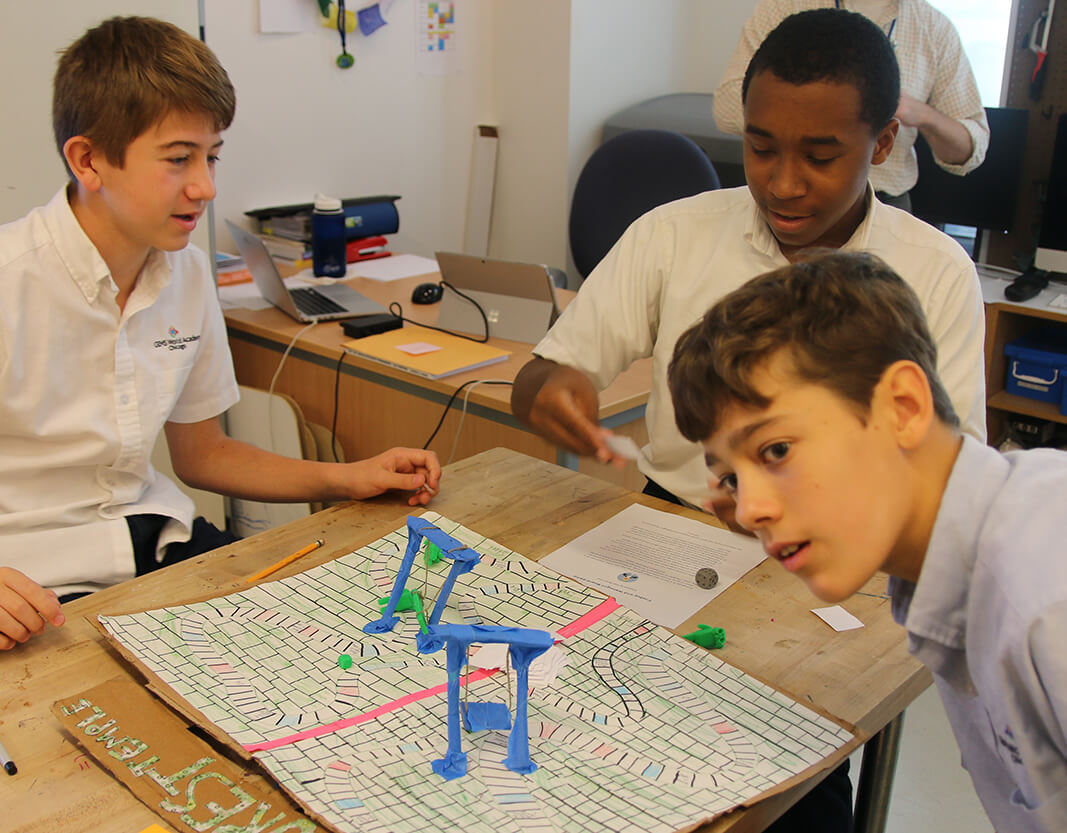
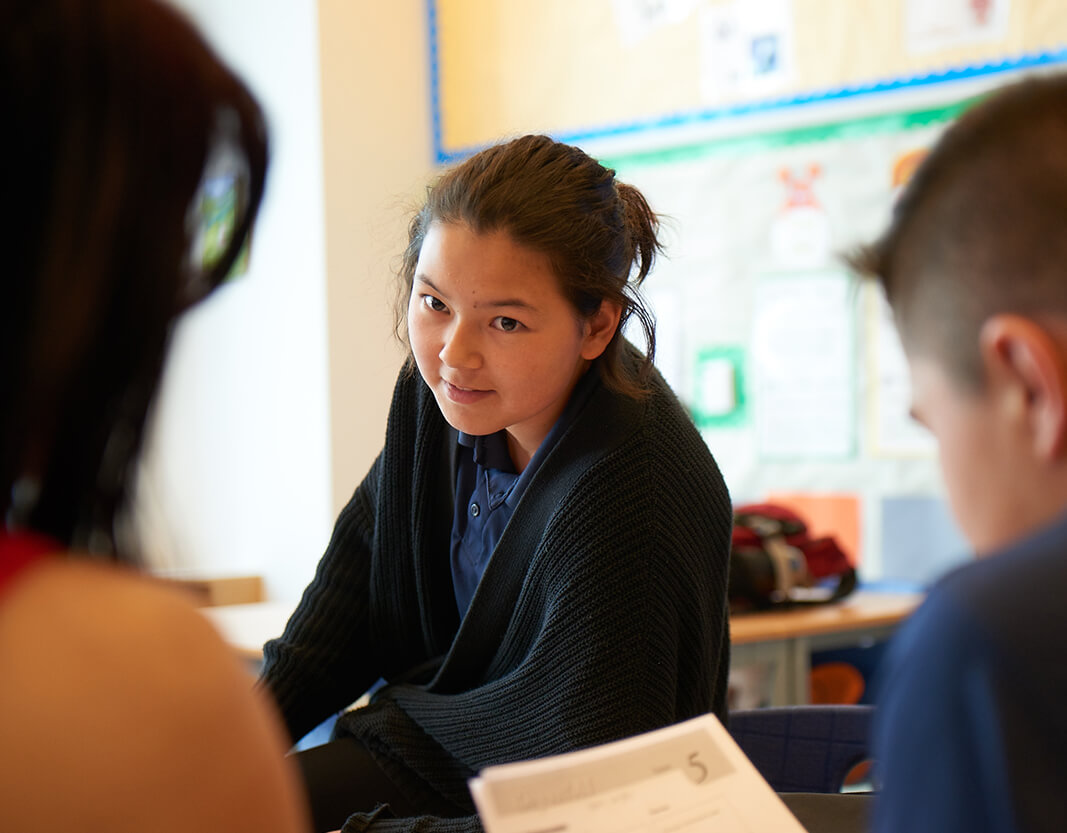
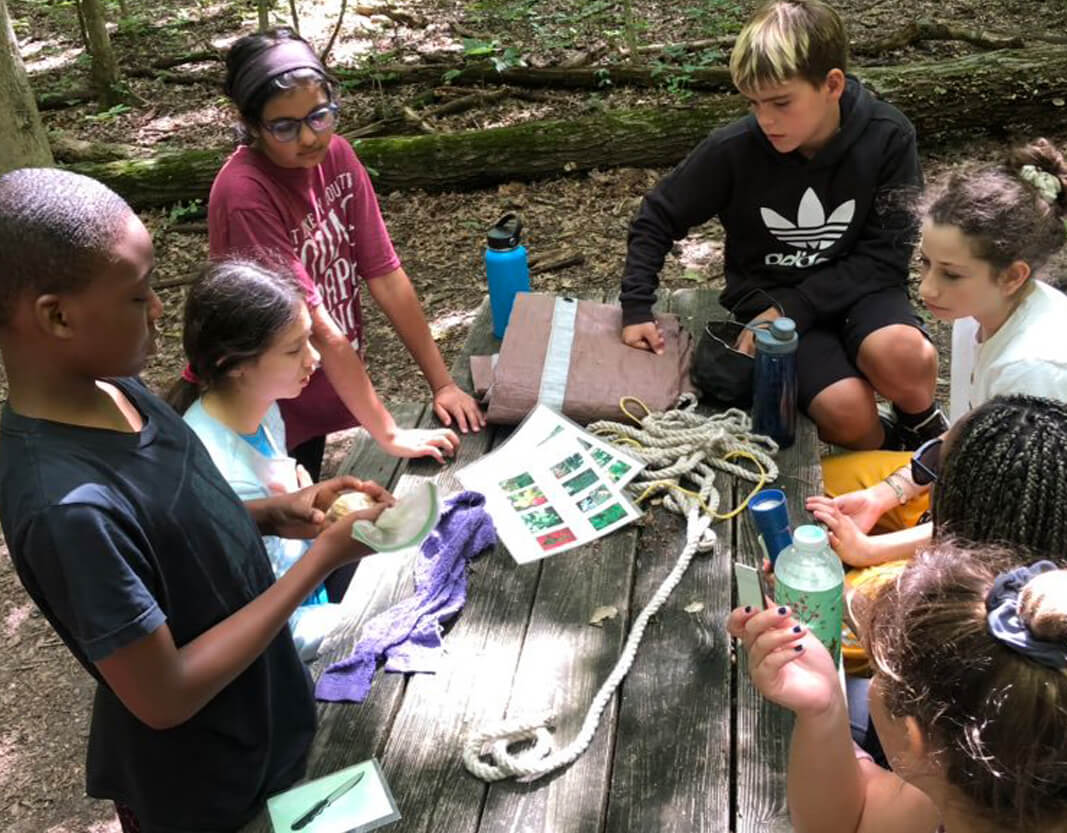



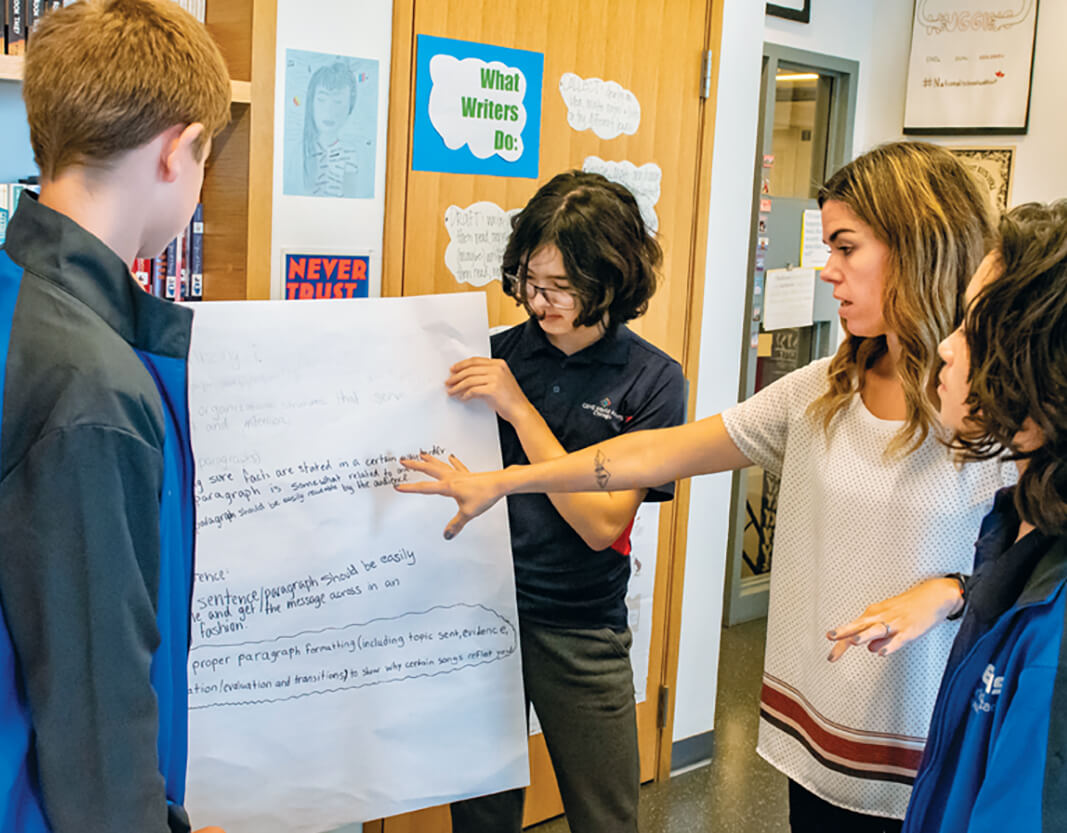
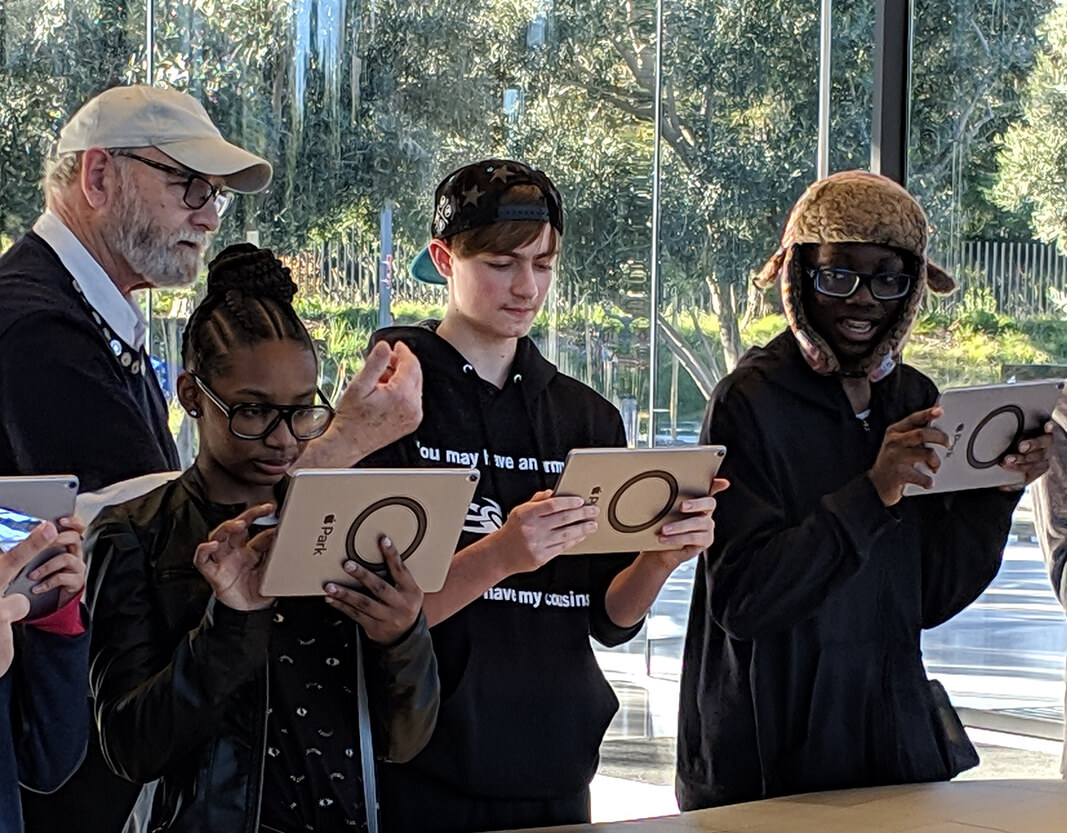
Communication Skills
Give and receive meaningful feedback, use intercultural understanding to interpret communication, use a variety of speaking techniques to communicate with a variety of audiences, and more.
Communicating through language
Reading, writing and using language to gather and communicate information, read critically and for comprehension, read a variety of sources for information and for pleasure, make inferences and draw conclusions, use and interpret a range of discipline-specific terms and symbols, and more.
Optional CTASocial/Collaboration Skills
Use social media networks appropriately to build and develop relationships, practice empathy, delegate and share responsibility for decision-making, help others to succeed, take responsibility for one’s own actions, manage and resolve conflict and work effectively in teams, build consensus, and more.
Optional CTAOrganizing
Plan short and long term assignments; meet deadlines, create plans to prepare for summative assessments, keep and use a planner for assignments and extracurricular commitments, set goals that are challenging and realistic, plan strategies and take action to achieve personal and academic goals, and more.
Managing State of Mind
Mindfulness, perseverance, emotional management, self-motivation, resilience.
Optional CTAReflection
Considering and re-considering what has been learned; choosing and using ATL skills.
Optional CTAResearch Skills
Information literacy: finding, interpreting, judging and creating information.
Media Literacy
Interacting with media to use and create ideas and information
DEVELOPING HIGH-LEVEL THINKING
Subject Areas
Subjects offered in middle school reflect our emphasis on global citizenship and well-rounded preparation for a future of unknowns. World language is considered a core discipline and our integration of technology in the classroom ensures that students develop 21st century skills.
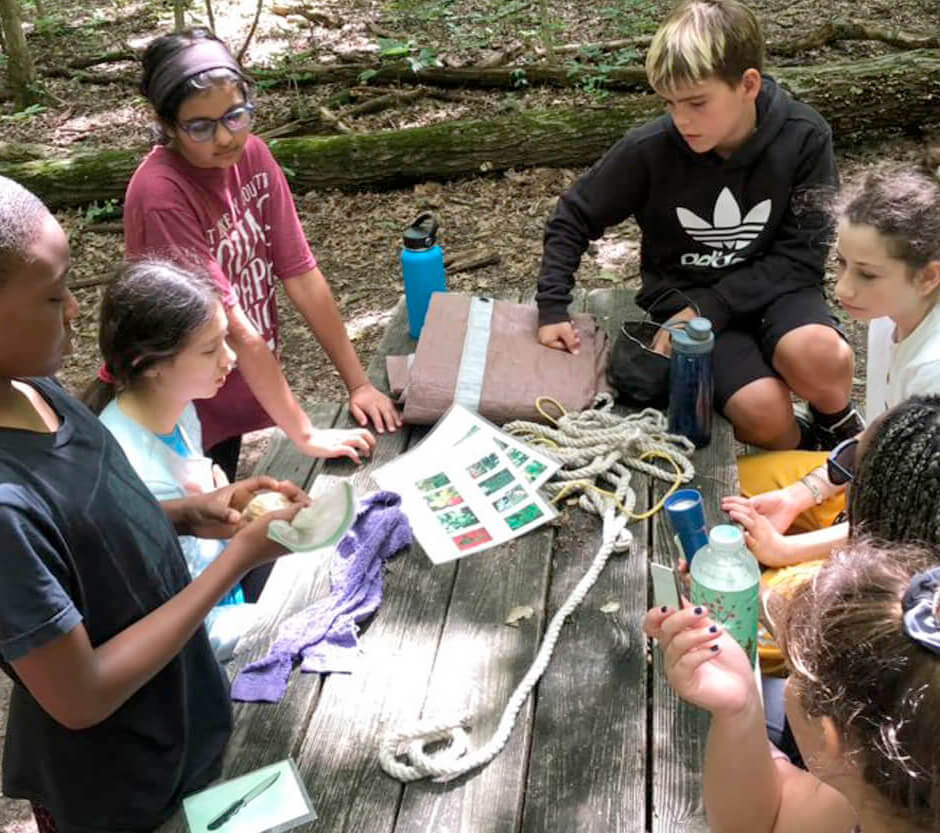

This course is an inquiry into the search for self through the study of creative expression and character experience. Through multiple genres and perspectives, this course explores the author's purpose, literary style, and word choice. Students delve into the influence of social constructions of reality and how conflict directs character. Actively reading, students learn to unpack texts through book clubs, note-taking strategies, annotating texts, and close reading. With an emphasis on writing as a process, students develop the skills to write personal narratives, argumentative, and informational essays. Writing workshops emphasize the practice of writing for different purposes and audiences, creating avenues for self-expression primarily with narrative and poetic writing.
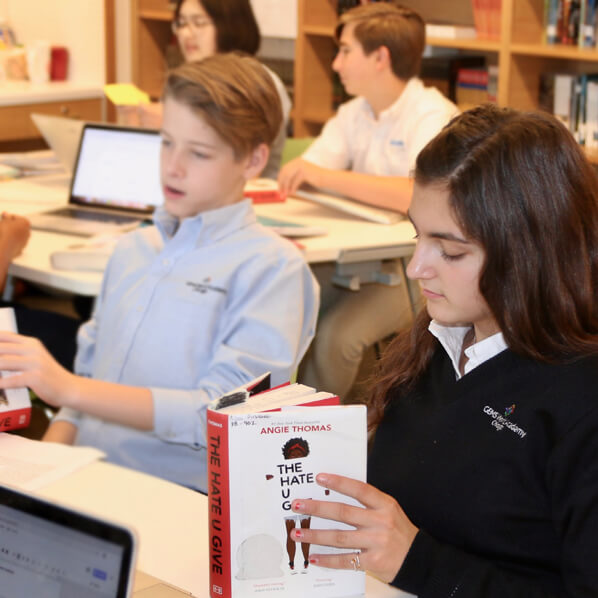
This course is an introduction into the study of global communities and characters through shared, guided, and independent readings. Students explore the concepts of power and belief, examining the role of setting in literary works. From an exploration into human nature to the power of imagination through dystopian fiction, students discuss various themes in literature. Students are exposed to a variety of genres, including short stories, dystopian fiction, research and narrative essays, and poetry. Through additional practice around development of writing skills, students workshop their writing, sharing the process in peer and teacher conferences. We use inquiry into global communities to develop literary analysis skills, serving as preparation for Year 3, where a more in-depth critical analysis is a major focus.

This course is closely tied to work in Individuals and Societies, helping students to answer the question through literature: What does it mean to be American? It serves as an in-depth, critical analysis where students comment on character experience through the individual’s search for self. Through literary expression, writers further develop voice and identity; this course explores how the character gains perspective based on setting and context. Students explore multiple identities that make up the American experience. Writing as a process serves as a major focus of the course, offering students the opportunity to share work and develop critical thinking skills. We develop skills around precision of language with word choice and sophisticated syntax, summarizing, arguing, informing and using literary devices. Literary genres include novels, short stories, poetry, memoir, personal and analytical essays, biographies, and autobiographies.


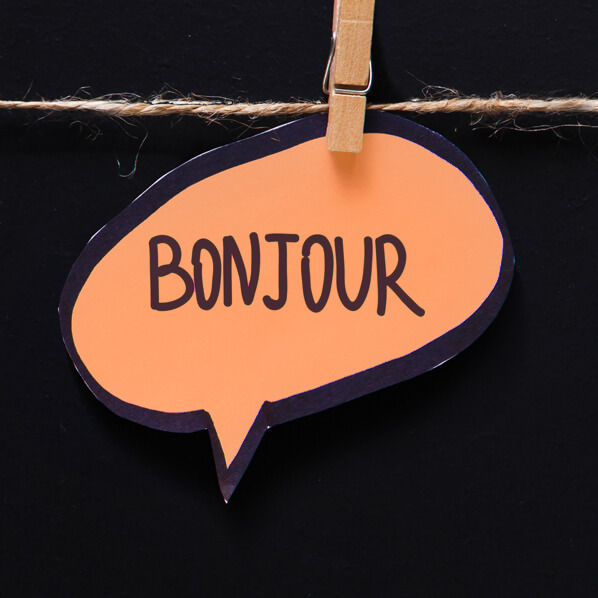
At GEMS world Academy Chicago, all students have a choice of world language starting in preschool. Students select between French, Mandarin, or Spanish and we encourage them to stay with the same language to support true mastery and fluency. We offer the following progression that naturally increases in complexity and challenge at each level; students are placed appropriately based on readiness.
- Novice I: This course is designed to help students begin to communicate with French speakers through written and oral expression. This course integrates language with history, culture, daily life, community, politics, health and our environment. We emphasize interconnectedness, global awareness and the broad movements and patterns of the history of French speakers around the world.
- Novice II: This course reinforces the basics of the French language. Each unit invites students to expand their French vocabulary, search for contextual clues decoding high level literary excerpts and a variety of authentic media resources as well as respond through communicative activities and projects
- Intermediate I and II: High-level French immersion, writing and speaking practice. Primary sources, authentic French articles, podcasts, media, music and film will be combined with research and field studies to insure students build a foundation in French to prepare for the IB Diploma Program.
- Advanced/Heritage: Designed for first language speakers, this course develops high level speaking, reading and writing skills Literature and other authentic texts are used to ensure that students are able to express higher order thinking in written and verbal communication.

At GEMS world Academy Chicago, all students have a choice of world language starting in preschool. Students select between French, Mandarin, or Spanish and we encourage them to stay with the same language to support true mastery and fluency. We offer the following progression that naturally increases in complexity and challenge at each level; students are placed appropriately based on readiness.
- Novice I: This course is designed to help students begin to communicate with French speakers through written and oral expression. This course integrates language with history, culture, daily life, community, politics, health and our environment. We emphasize interconnectedness, global awareness and the broad movements and patterns of the history of French speakers around the world.
- Novice II: This course reinforces the basics of the French language. Each unit invites students to expand their French vocabulary, search for contextual clues decoding high level literary excerpts and a variety of authentic media resources as well as respond through communicative activities and projects.
- Intermediate I and II: High-level French immersion, writing and speaking practice. Primary sources, authentic French articles, podcasts, media, music and film will be combined with research and field studies to insure students build a foundation in French to prepare for the IB Diploma Program.
- Advanced/Heritage: Designed for first language speakers, this course develops high level speaking, reading and writing skills. Literature and other authentic texts are used to ensure that students are able to express higher order thinking in written and verbal communication.

At GEMS world Academy Chicago, all students have a choice of world language starting in preschool. Students select between French, Mandarin, or Spanish and we encourage them to stay with the same language to support true mastery and fluency. We offer the following progression that naturally increases in complexity and challenge at each level; students are placed appropriately based on readiness.
- Novice I: This course is designed to help students begin to communicate with French speakers through written and oral expression. This course integrates language with history, culture, daily life, community, politics, health and our environment. We emphasize interconnectedness, global awareness and the broad movements and patterns of the history of French speakers around the world.
- Novice II: This course reinforces the basics of the French language. Each unit invites students to expand their French vocabulary, search for contextual clues decoding high level literary excerpts and a variety of authentic media resources as well as respond through communicative activities and projects.
- Intermediate I and II: High-level French immersion, writing and speaking practice. Primary sources, authentic French articles, podcasts, media, music and film will be combined with research and field studies to insure students build a foundation in French to prepare for the IB Diploma Program.
- Advanced/Heritage: Designed for first language speakers, this course develops high level speaking, reading and writing skills. Literature and other authentic texts are used to ensure that students are able to express higher order thinking in written and verbal communication



At GEMS world Academy Chicago, all students have a choice of world language starting in preschool. Students select between French, Mandarin, or Spanish and we encourage them to stay with the same language to support true mastery and fluency
We offer the following progression that naturally increases in complexity and challenge at each level; students are placed appropriately based on readiness.
- Novice I:This is a course geared toward preparing students for the IB Diploma Mandarin course. Each unit is designed around life-related themes to integrate the key facets of foreign language acquisition: linguistic codes, language usage skills, and cultural knowledge. It introduces the Chinese phonetic system, character writing system, basic grammatical structures, and functional daily language use in a real-life related context. The students are expected to get actively involved in daily classroom instruction/activities in the target language to improve their communicative skills. The main goal of this course is to get students interested in the language and the culture and help them succeed in daily functional conversation, reading and writing. Students are encouraged to achieve independent thinking and creative use of the language.
- Novice II:This course provides further development of all language skills: codes, language usage skills, and cultural knowledge. Additionally, students are expected to develop Chinese vocabulary and sentence patterns in communicative contexts, and to build a solid foundation in pronunciation.
- Intermediate:This course provides high level immersion, writing, and speaking practice. Primary sources, authentic articles, podcasts, media, music and film are combined with research and field studies to ensure that students build a foundation to prepare for the demands of the IB Diploma Program.
- Advanced/Heritage: Designed for first language speakers, this course develops high level speaking, reading and writing skills. Literature and other authentic texts are used to ensure that students are able to express higher order thinking in written and verbal communication.

At GEMS world Academy Chicago, all students have a choice of world language starting in preschool. Students select between French, Mandarin, or Spanish and we encourage them to stay with the same language to support true mastery and fluency
We offer the following progression that naturally increases in complexity and challenge at each level; students are placed appropriately based on readiness.
- Novice I:This is a course geared toward preparing students for the IB Diploma Mandarin course. Each unit is designed around life-related themes to integrate the key facets of foreign language acquisition: linguistic codes, language usage skills, and cultural knowledge. It introduces the Chinese phonetic system, character writing system, basic grammatical structures, and functional daily language use in a real-life related context. The students are expected to get actively involved in daily classroom instruction/activities in the target language to improve their communicative skills. The main goal of this course is to get students interested in the language and the culture and help them succeed in daily functional conversation, reading and writing. Students are encouraged to achieve independent thinking and creative use of the language.
- Novice II:This course provides further development of all language skills: codes, language usage skills, and cultural knowledge. Additionally, students are expected to develop Chinese vocabulary and sentence patterns in communicative contexts, and to build a solid foundation in pronunciation.
- Intermediate:This course provides high level immersion, writing, and speaking practice. Primary sources, authentic articles, podcasts, media, music and film are combined with research and field studies to ensure that students build a foundation to prepare for the demands of the IB Diploma Program.
- Advanced/Heritage: Designed for first language speakers, this course develops high level speaking, reading and writing skills. Literature and other authentic texts are used to ensure that students are able to express higher order thinking in written and verbal communication.

At GEMS world Academy Chicago, all students have a choice of world language starting in preschool. Students select between French, Mandarin, or Spanish and we encourage them to stay with the same language to support true mastery and fluency
We offer the following progression that naturally increases in complexity and challenge at each level; students are placed appropriately based on readiness.
- Novice I:This is a course geared toward preparing students for the IB Diploma Mandarin course. Each unit is designed around life-related themes to integrate the key facets of foreign language acquisition: linguistic codes, language usage skills, and cultural knowledge. It introduces the Chinese phonetic system, character writing system, basic grammatical structures, and functional daily language use in a real-life related context. The students are expected to get actively involved in daily classroom instruction/activities in the target language to improve their communicative skills. The main goal of this course is to get students interested in the language and the culture and help them succeed in daily functional conversation, reading and writing. Students are encouraged to achieve independent thinking and creative use of the language.
- Novice II:This course provides further development of all language skills: codes, language usage skills, and cultural knowledge. Additionally, students are expected to develop Chinese vocabulary and sentence patterns in communicative contexts, and to build a solid foundation in pronunciation.
- Intermediate:This course provides high level immersion, writing, and speaking practice. Primary sources, authentic articles, podcasts, media, music and film are combined with research and field studies to ensure that students build a foundation to prepare for the demands of the IB Diploma Program.
- Advanced/Heritage: Designed for first language speakers, this course develops high level speaking, reading and writing skills. Literature and other authentic texts are used to ensure that students are able to express higher order thinking in written and verbal communication.


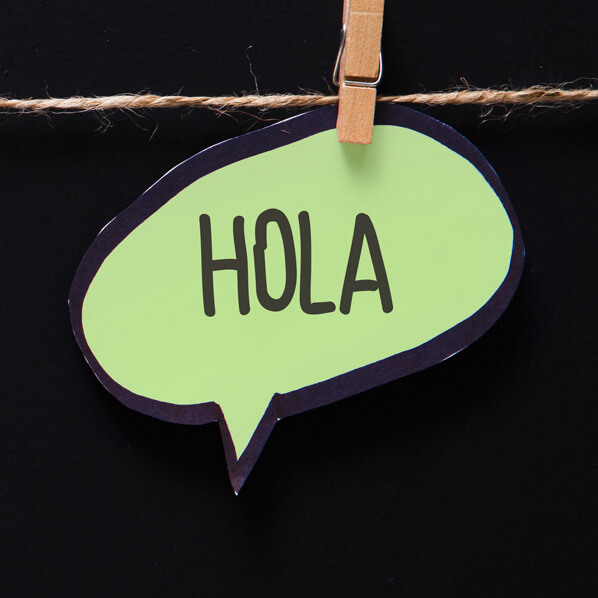
At GEMS world Academy Chicago, all students have a choice of world language starting in preschool. Students select between French, Mandarin, or Spanish and we encourage them to stay with the same language to support true mastery and fluency. We offer the following progression that naturally increases in complexity and challenge at each level; students are placed appropriately based on readiness.
- Novice I: This course is designed to help students begin to communicate with Spanish speakers through written and oral expression, integrating language with history, culture, daily life, community, politics, health and our environment. We emphasize interconnectedness, global awareness, and the broad movements and patterns of the history of Spanish speakers.
- Novice II: As a progression of Novice I, more challenging vocabulary and grammatical (reading and writing) structures are taught in context
- Intermediate I and II: We continue to develop students'oral (communication), aural (listening), written, and reading competences while expanding prior knowledge of language structure and cultural awareness. Students will learn the World Language standards of communication: Interpersonal (speaking + listening or writing + reading); Interpretive (reading, listening, viewing); Presentational (writing, speaking, visually representing). This language course will challenge students to further acquire linguistic and cultural skills. In the classroom applications we will integrate cultures, make connections and comparisons through global communities while communicating in the target language.
- Advanced/Heritage: Designed for first language speakers, this course develops high level speaking, reading and writing skills. Literature and other authentic texts are used to ensure that students are able to express higher order thinking in written and verbal communication.

At GEMS world Academy Chicago, all students have a choice of world language starting in preschool. Students select between French, Mandarin, or Spanish and we encourage them to stay with the same language to support true mastery and fluency. We offer the following progression that naturally increases in complexity and challenge at each level; students are placed appropriately based on readiness.
- Novice I: This course is designed to help students begin to communicate with Spanish speakers through written and oral expression, integrating language with history, culture, daily life, community, politics, health and our environment. We emphasize interconnectedness, global awareness, and the broad movements and patterns of the history of Spanish speakers.
- Novice II: As a progression of Novice I, more challenging vocabulary and grammatical (reading and writing) structures are taught in context.
- Intermediate I and II: We continue to develop students'oral (communication), aural (listening), written, and reading competences while expanding prior knowledge of language structure and cultural awareness. Students will learn the World Language standards of communication: Interpersonal (speaking + listening or writing + reading); Interpretive (reading, listening, viewing); Presentational (writing, speaking, visually representing). This language course will challenge students to further acquire linguistic and cultural skills. In the classroom applications we will integrate cultures, make connections and comparisons through global communities while communicating in the target language.
- Advanced/Heritage: Designed for first language speakers, this course develops high level speaking, reading and writing skills. Literature and other authentic texts are used to ensure that students are able to express higher order thinking in written and verbal communication.

At GEMS world Academy Chicago, all students have a choice of world language starting in preschool. Students select between French, Mandarin, or Spanish and we encourage them to stay with the same language to support true mastery and fluency. We offer the following progression that naturally increases in complexity and challenge at each level; students are placed appropriately based on readiness.
- Novice I: This course is designed to help students begin to communicate with Spanish speakers through written and oral expression, integrating language with history, culture, daily life, community, politics, health and our environment. We emphasize interconnectedness, global awareness, and the broad movements and patterns of the history of Spanish speakers.
- Novice II: As a progression of Novice I, more challenging vocabulary and grammatical (reading and writing) structures are taught in context.
- Intermediate I and II: We continue to develop students’ oral (communication), aural (listening), written, and reading competences while expanding prior knowledge of language structure and cultural awareness. Students will learn the World Language standards of communication: Interpersonal (speaking + listening or writing + reading); Interpretive (reading, listening, viewing); Presentational (writing, speaking, visually representing). This language course will challenge students to further acquire linguistic and cultural skills. In the classroom applications we will integrate cultures, make connections and comparisons through global communities while communicating in the target language.
- Advanced/Heritage: Designed for first language speakers, this course develops high level speaking, reading and writing skills. Literature and other authentic texts are used to ensure that students are able to express higher order thinking in written and verbal communication.


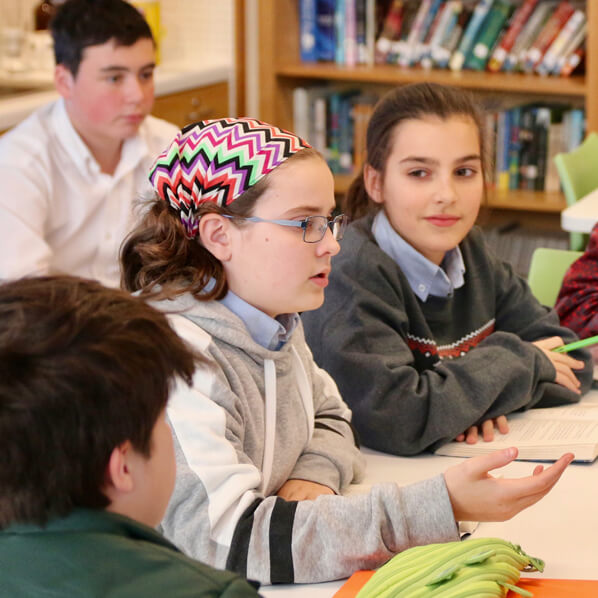
Students examine the long, multifaceted story of the human race through a variety of lenses. Along the way, the students build essential skills - critical thinking, reading, writing, problem solving, communicating - and a deep appreciation for the different cultures that have contributed to the human story. Students are guided through an intensive study of humanity's past, considering changes in government, religion, commerce, science/technology, education, art, ecology and more.

Students examine the long, multifaceted story of the human race through a variety of lenses. Along the way, the students build essential skills - critical thinking, reading, writing, problem solving, communicating - and a deep appreciation for the different cultures that have contributed to the human story. Students are guided through an intensive study of humanity’s past, considering changes in government, religion, commerce, science/technology, education, art, ecology and more

This course explores how the history of the United States continues to play a role in our country today. Students shift their focus to understanding the emergence of America, exploring and debating the complexity of articulating the American identity. Students uncover how rebellion, revolution and oppression play a role in America's past and present by examining key historical events and pinpointing contemporary issues that draw comparisons. As students continue to refine their note-taking, analysis and writing skills, they produce a variety of multimedia projects and longer persuasive and informative writing pieces that clearly convey their critical thinking and provide opportunities for further questioning.


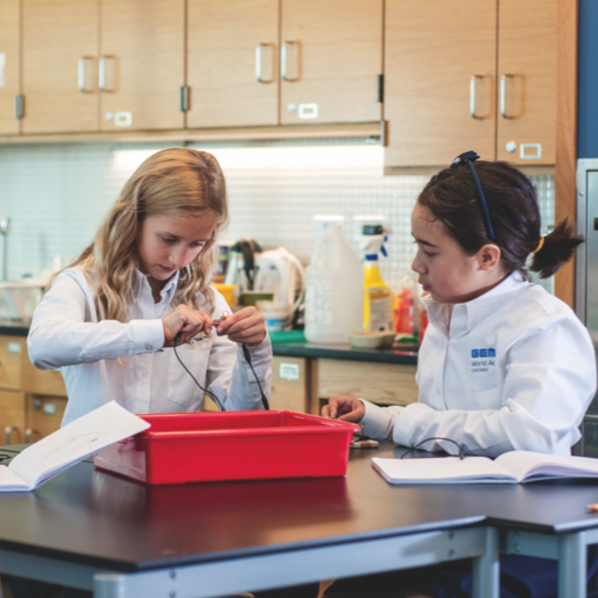
The focus of sixth grade is ecology — species, communities and ecosystems. We explore energy flow, carbon recycling and climate change by examining the principles of modern science through process and ethical implications that affect these concepts. Students begin to explore the fundamentals in science by examining the processes and concepts that reach to a wider community. Specific topics covered include classification and biodiversity, evidence of evolution, natural selection, metabolism, cell respiration and photosynthesis, with regular review of the scientific method and design.

Seventh-graders study chemistry and physical sciences. In chemistry, students examine environmental systems sustained through chemistry. Physics will examine energy, forces, electricity and magnetism through a process that allows students to improve, progress and create further scientific investigation.

Eighth-grade science covers biology and anatomy & physiology. Students explore fundamental principles of Mendelian genetics in pea plants and humans. They study asexual and sexual reproduction, the process of cell division, and the role of nature and nurture in determining traits. Students explore DNA technologies with a focus on how they can solve real-world problems. The students compare and contrast major aspects of anatomy of vertebrates and invertebrates, including basic comparative anatomy and a laboratory component that examines systems with deductive and inductive reasoning components that lead to specific conclusions.


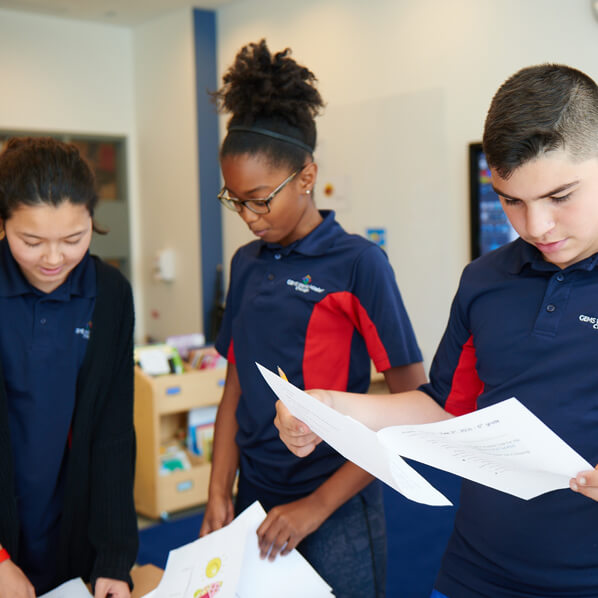
This course presents a deep, multi-faceted and rigorous study building on our previous work with rational numbers, and delves deeper into numbers as the language of math. MYP mathematics courses promote both inquiry and application, helping students to develop problem-solving techniques that transcend the discipline and are useful in the world outside school. Students should see authentic examples of how mathematics is useful and relevant to their lives and be encouraged to apply it to new situations.
Examples of topics and concepts covered include:
- Ratios and Proportional Relationships: Ratios, Rates, Equivalence in Fractions, Decimals and Percents, Percent Applications
- Geometry: Area of Polygons and Irregular Figures, Volume and Surface Area of Prisms and Pyramids
- Statistics & Probability: Measures of Central Tendency, Measures of Variation, Mean Absolute Deviation, Statistical Displays, Box and Whisker Plots

This course builds on our previous work with rational numbers, and it is the beginning of a new journey in mathematics, elevating algebra as the language of math. Examples of topics and concepts covered include:
- The Number System: Integers, Rational vs. Irrational Numbers, Signed Decimals and Fractions
- Expressions & Equations: Manipulating Expressions, Solving Two-Step Equations and Inequalities in Context
- Geometry: Angle Pair Relationships, Circles, Volume & Surface Area
- Statistics & Probability: Theoretical & Experimental Probability, Compound Probability, Sampling

Grade 8 math provides 2 different courses for students:
- Grade 8 Math: a continuation of the complex topics covered in grade 7 math
- Algebra I: This course elevates algebra as the language of math, weaving its way through all the various domains of the discipline - geometry, statistics, etc.Students will also dive into the world of various functions - linear, quadratic, absolute value, and exponential - as they begin to view the relationships that underlie our world through a mathematical lens.


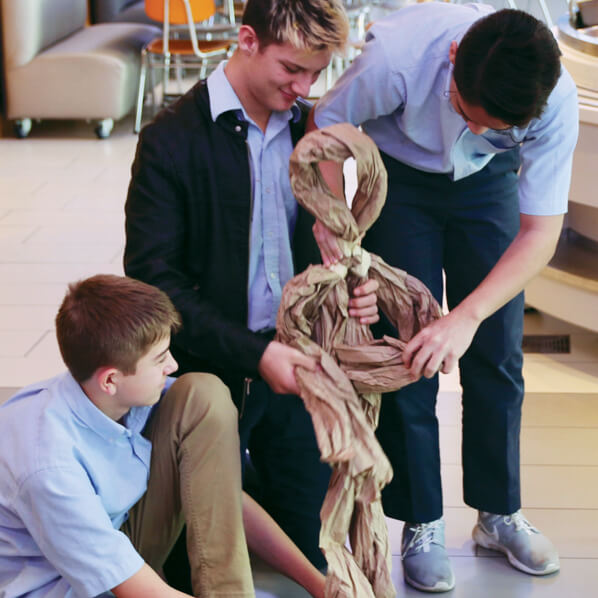
Design is one of the four semester-long required arts courses in grades 6 through 8. Each course meets for three hours/week.
We are very fortunate to have stand-alone Design class where we can teach the Design Cycle explicitly. Students are responsible for maintaining a process journal as they work on a project in class. This involves students evaluating their own learning process and development. As they reflect, they develop critical thinking and relate to concept and composition development, research, documentation, reflection, presentation, aesthetics, and craftsmanship. Topics and projects include:
- 3D printing: The ability to use resources such as CAD tools allows for the innovative development of products.
- Cells (interdisciplinary with Science)
- Bridge design: Engineering development decisions are based on available resources, design specifications, and a fundamental understanding of physics.
Arduino Coding Systems and products that are designed to meet an individual user's ergonomic requirements can increase their ability to function and communicate.

Design is one of the four semester-long required arts courses in grades 6 through 8. Each course meets for three hours/week.
We are very fortunate to have stand-alone Design class where we can teach the Design Cycle explicitly. Students are responsible for maintaining a process journal as they work on a project in class. This involves students evaluating their own learning process and development. As they reflect, they develop critical thinking and relate to concept and composition development, research, documentation, reflection, presentation, aesthetics, and craftsmanship. Topics and projects include:
- 3D printing: The ability to use resources such as CAD tools allows for the innovative development of products.
- Cells (interdisciplinary with Science)
- Bridge design: Engineering development decisions are based on available resources, design specifications, and a fundamental understanding of physics.
Arduino Coding Systems and products that are designed to meet an individual user's ergonomic requirements can increase their ability to function and communicate.

Design is one of the four semester-long required arts courses in grades 6 through 8. Each course meets for three hours/week.
We are very fortunate to have stand-alone Design class where we can teach the Design Cycle explicitly. Students are responsible for maintaining a process journal as they work on a project in class. This involves students evaluating their own learning process and development. As they reflect, they develop critical thinking and relate to concept and composition development, research, documentation, reflection, presentation, aesthetics, and craftsmanship. Topics and projects include:
- 3D printing: The ability to use resources such as CAD tools allows for the innovative development of products.
- Cells (interdisciplinary with Science)
- Bridge design: Engineering development decisions are based on available resources, design specifications, and a fundamental understanding of physics.
Arduino Coding Systems and products that are designed to meet an individual user's ergonomic requirements can increase their ability to function and communicate.


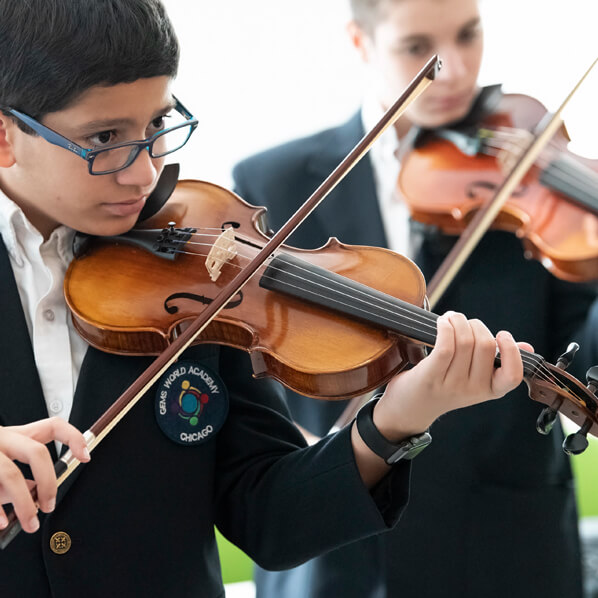
Music is one of the four semester-long required arts courses in grades 6 through 8. Each course meets for three hours/week.
This course, and music education at GEMS in general, holds the acquisition of musical skill and the theory of musical practice at its heart. During Orchestra and Choir, units are designed to approach the technical skill of perfecting an instrument, whether it is the voice or an orchestral instrument. We are partnered with the New Music School of Chicago, who provide us with professional educators and performers of their given instruments. The orchestra currently offers a differentiated learning experience in violin, viola, cello, flute, oboe, and clarinet. Instruments instruction happens in small groups divided by instrument and also level of experience. Students also get the experience of playing in larger groups of blended instruments (Strings together, Woodwinds together) regularly.

Music is one of the four semester-long required arts courses in grades 6 through 8. Each course meets for three hours/week.
This course, and music education at GEMS in general, holds the acquisition of musical skill and the theory of musical practice at its heart. During Orchestra and Choir, units are designed to approach the technical skill of perfecting an instrument, whether it is the voice or an orchestral instrument. We are partnered with the New Music School of Chicago, who provide us with professional educators and performers of their given instruments. The orchestra currently offers a differentiated learning experience in violin, viola, cello, flute, oboe, and clarinet. Instruments instruction happens in small groups divided by instrument and also level of experience. Students also get the experience of playing in larger groups of blended instruments (Strings together, Woodwinds together) regularly.

Music is one of the four semester-long required arts courses in grades 6 through 8. Each course meets for three hours/week.
This course, and music education at GEMS in general, holds the acquisition of musical skill and the theory of musical practice at its heart. During Orchestra and Choir, units are designed to approach the technical skill of perfecting an instrument, whether it is the voice or an orchestral instrument. We are partnered with the New Music School of Chicago, who provide us with professional educators and performers of their given instruments. The orchestra currently offers a differentiated learning experience in violin, viola, cello, flute, oboe, and clarinet. Instruments instruction happens in small groups divided by instrument and also level of experience. Students also get the experience of playing in larger groups of blended instruments (Strings together, Woodwinds together) regularly.


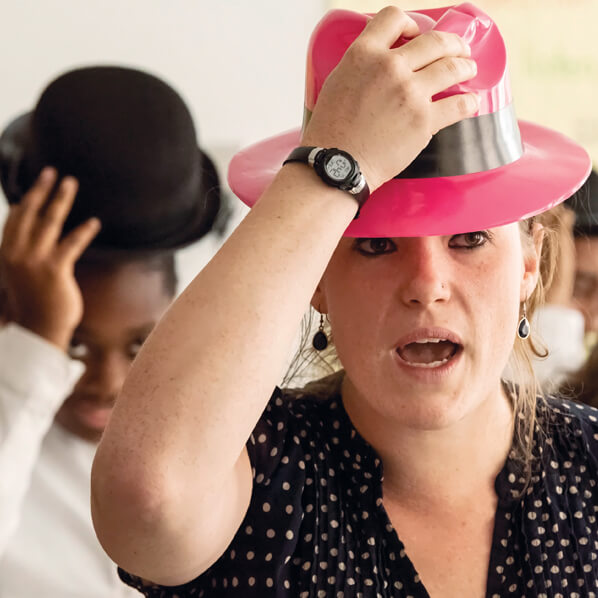
Performing Arts is one of the four semester-long required arts courses in grades 6 through 8. Each course meets for three hours/week.
This course focuses on providing students with the basic skills of performing arts and creative dramatics. Within the program, students will refine their communication and performance skills, gain a deeper understanding of the history and practice of theater and investigate how drama can be used as a catalyst for social change and reflection. Additionally, students will be provided opportunities to exhibit and implement their collaboration and performance techniques within small- and large-group settings. Students learn basic theater terminology, refine their communication skills and gain a deeper understanding of the history and practice of theater as an art form. Additionally, they are exposed to production and performance skills on an introductory level through a wide range of actor training, including games, storytelling, movement/ vocal exercises and improvisation. Students will be given the opportunity to showcase the culmination of their learning through monologues, short scenes, and one act performances.

Performing Arts is one of the four semester-long required arts courses in grades 6 through 8. Each course meets for three hours/week.
This course focuses on providing students with the basic skills of performing arts and creative dramatics. Within the program, students will refine their communication and performance skills, gain a deeper understanding of the history and practice of theater and investigate how drama can be used as a catalyst for social change and reflection. Additionally, students will be provided opportunities to exhibit and implement their collaboration and performance techniques within small- and large-group settings. Students learn basic theater terminology, refine their communication skills and gain a deeper understanding of the history and practice of theater as an art form. Additionally, they are exposed to production and performance skills on an introductory level through a wide range of actor training, including games, storytelling, movement/ vocal exercises and improvisation. Students will be given the opportunity to showcase the culmination of their learning through monologues, short scenes, and one act performances.

Performing Arts is one of the four semester-long required arts courses in grades 6 through 8. Each course meets for three hours/week.
This course focuses on providing students with the basic skills of performing arts and creative dramatics. Within the program, students will refine their communication and performance skills, gain a deeper understanding of the history and practice of theater and investigate how drama can be used as a catalyst for social change and reflection. Additionally, students will be provided opportunities to exhibit and implement their collaboration and performance techniques within small- and large-group settings. Students learn basic theater terminology, refine their communication skills and gain a deeper understanding of the history and practice of theater as an art form. Additionally, they are exposed to production and performance skills on an introductory level through a wide range of actor training, including games, storytelling, movement/ vocal exercises and improvisation. Students will be given the opportunity to showcase the culmination of their learning through monologues, short scenes, and one act performances.


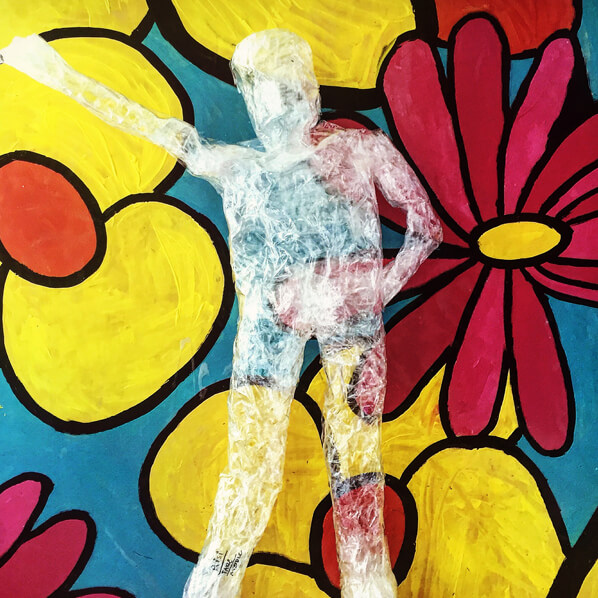
Visual arts is one of the four semester-long required arts courses in grades 6 through 8. Each course meets for three hours/week.
In this course, students use a variety of media to investigate concepts of culture, identity, and global perspectives as they develop their practice using the principles and elements of art as a foundation. Students will also have the opportunity for interdisciplinary learning experiences with our social studies, English, language and science programs. We will explore concepts involving the environment, making personal connections within our own art and the art of different cultures and time periods. Examples of units include:
- What's in a Name? Students will explore their heritage, cultural and ethnic backgrounds, consider what it means to them to be a part of America, and create an original work that reflects their personal backgrounds in both a visual and global context.
- Story Book Panels: Using clay, students will create a relief panel illustrating their favorite stories. Students will draw inspiration from Lorenzo Ghibertis's panels adorned on the Gates of Paradise in Florence, Italy.
- Tapestry and Shibori: Students will learn if the history of color theory, and pigment, creating tapestries or t-shirts that demonstrate an understanding of pattern, color, and traditional Japanese aesthetics

Visual arts is one of the four semester-long required arts courses in grades 6 through 8. Each course meets for three hours/week.
In this course, students use a variety of media to investigate concepts of culture, identity, and global perspectives as they develop their practice using the principles and elements of art as a foundation. Students will also have the opportunity for interdisciplinary learning experiences with our social studies, English, language and science programs. We will explore concepts involving the environment, making personal connections within our own art and the art of different cultures and time periods. Examples of units include:
- What's in a Name? Students will explore their heritage, cultural and ethnic backgrounds, consider what it means to them to be a part of America, and create an original work that reflects their personal backgrounds in both a visual and global context.
- Story Book Panels: Using clay, students will create a relief panel illustrating their favorite stories. Students will draw inspiration from Lorenzo Ghibertis's panels adorned on the Gates of Paradise in Florence, Italy.
- Tapestry and Shibori: Students will learn if the history of color theory, and pigment, creating tapestries or t-shirts that demonstrate an understanding of pattern, color, and traditional Japanese aesthetics.

Visual arts is one of the four semester-long required arts courses in grades 6 through 8. Each course meets for three hours/week.
In this course, students use a variety of media to investigate concepts of culture, identity, and global perspectives as they develop their practice using the principles and elements of art as a foundation. Students will also have the opportunity for interdisciplinary learning experiences with our social studies, English, language and science programs. We will explore concepts involving the environment, making personal connections within our own art and the art of different cultures and time periods. Examples of units include:
- What's in a Name? Students will explore their heritage, cultural and ethnic backgrounds, consider what it means to them to be a part of America, and create an original work that reflects their personal backgrounds in both a visual and global context.
- Story Book Panels: Using clay, students will create a relief panel illustrating their favorite stories. Students will draw inspiration from Lorenzo Ghibertis's panels adorned on the Gates of Paradise in Florence, Italy.
- Tapestry and Shibori: Students will learn if the history of color theory, and pigment, creating tapestries or t-shirts that demonstrate an understanding of pattern, color, and traditional Japanese aesthetics.


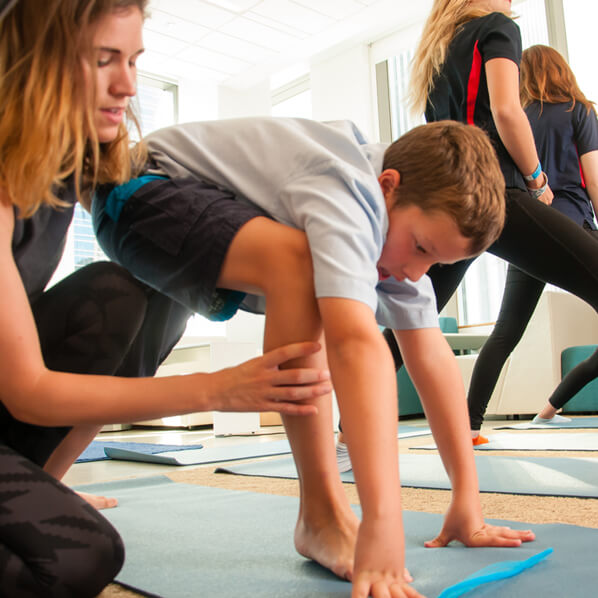
Physical and Health Education aims to empower students to understand and appreciate the value of being physically active and develop the motivation for making healthy life choices. Students explore key concepts of communication, change, relationships, and form in connection to physical activity. Using a holistic approach to address students' intellectual, social, emotional and physical well-being, the course will present a variety of opportunities and activities for learning and growth. A separate health class includes study on social, emotional, and physical health, including character, human body, nutrition, making healthy choices, and navigating change.

A continuation of grade 6 Physical and Health Education. Topics and sports covered include: communicating as a coach or leader through yoga and volleyball, swing mechanics in squash and badminton, development of personal exercise plans, form and efficient energy use through swimming and soccer. A separate health class includes study on social, emotional, and physical health, including character, human body, nutrition, making healthy choices, and navigating change.

A continuation of grade 7 Physical and Health Education. The sports of grades 6 are revisited, and topics covered include: communicating as a referee or judge, refinement and specialization in playing style, self-critique and planning to improve, form and spacing, and adaptive physical activity. A separate health class includes study on social, emotional, and physical health, including character, human body, nutrition, making healthy choices, and navigating change.


It’s an honor being a GEMS parent and seeing my son experience the world face-to-face in his education.
We put a lot of time and research into finding the best possible school environment for our daughter, and every day confirms that we made the right choice by choosing GEMS World Academy.





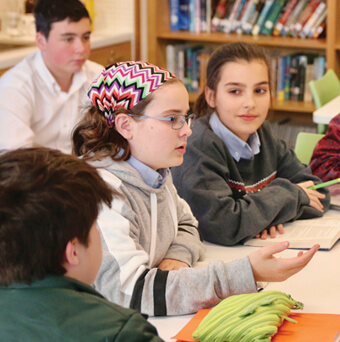

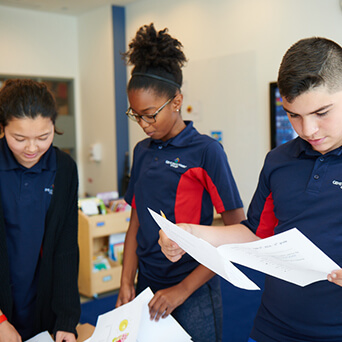
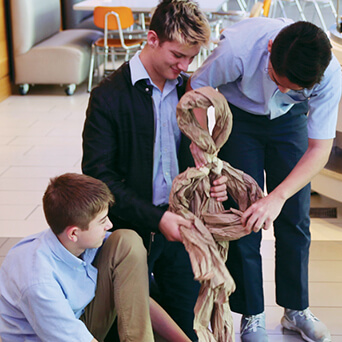
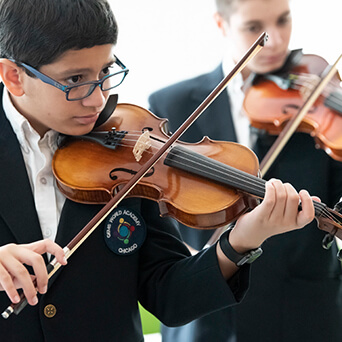
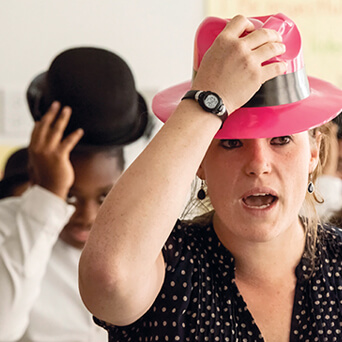

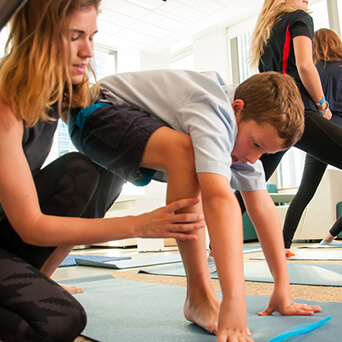
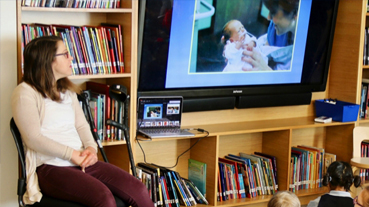
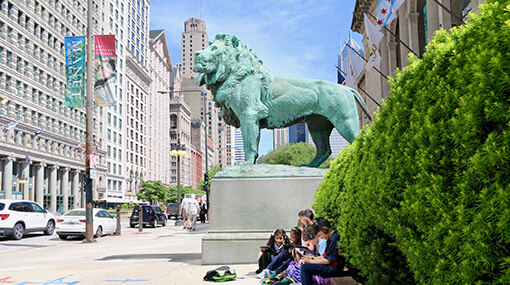
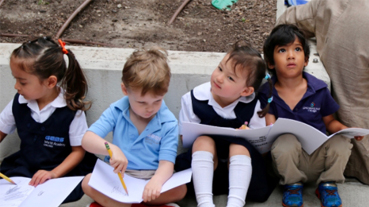


 For an optimal experience, please<br> rotate your device to portrait mode.
For an optimal experience, please<br> rotate your device to portrait mode.